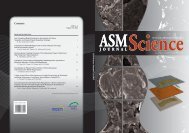Download - Akademi Sains Malaysia
Download - Akademi Sains Malaysia
Download - Akademi Sains Malaysia
You also want an ePaper? Increase the reach of your titles
YUMPU automatically turns print PDFs into web optimized ePapers that Google loves.
Journal of Science and Technology in the Tropics (2010) 6: 23-30<br />
The mammal fauna of Pulau Singa Besar, Langkawi, Kedah,<br />
Peninsular <strong>Malaysia</strong><br />
Lim Boo Liat1 , Norhayati Ahmad2,3 , O. Noor Alif Wira4 , Shahrul Anuar Md. Sah5 1Jalan Koop Cuepacs 3 E, Taman Cuepacs, 43200 Cheras, Selangor, <strong>Malaysia</strong><br />
2School of Environment and Natural Resource Sciences, Faculty of Science and Technology,<br />
University Kebangsaan <strong>Malaysia</strong>, 43600 UKM Bangi, Selangor, <strong>Malaysia</strong><br />
3Institute for Environment & Development (LESTARI) , Universiti Kebangsaan <strong>Malaysia</strong>,<br />
43600 UKM Bangi, Selangor, <strong>Malaysia</strong><br />
4Department of Wildlife and National Parks, Penang, <strong>Malaysia</strong><br />
5Department of Biological Science, Universiti <strong>Sains</strong> <strong>Malaysia</strong>, Penang, <strong>Malaysia</strong><br />
(Email: chizlim54@yahoo.com)<br />
Abstract Studies on the mammal fauna of Pulau Singa Besar, Langkawi were carried out during 2001<br />
and 2002. A total of 51 species – 21 non volant and 30 volant species – from past and recent studies were<br />
recorded. Two species, the Smooth otter (Lutrogale perspicillata) and Indian False vampire (Megaderma<br />
lyra) are new records for the Langkawi Archipelago. The species diversity between the non volant and volant<br />
mammals is discussed.<br />
Keywords mammals – <strong>Malaysia</strong> – bats – diversity – island<br />
INTRODUCTION<br />
Pulau Singar Besar, Langkawi is one of the 104 islands<br />
in the Langkawi Island archipelago. It is a permanent<br />
forest reserve, uninhabited, and was established as a<br />
bird and animal sanctuary in 1990. The island consists<br />
of various pristine forest types, such as dipterocarp<br />
lowland tropical forest, mangrove coastal forest, and<br />
sandy beach forest. In terms of the mammal fauna,<br />
the island has been known for the high density of<br />
mousedeer (Tragulus kanchil, T. napu), wildboar<br />
(Sus scrofa), and Long-tailed macaque (Macaca<br />
fascicularis).<br />
Not much was known of its mammal species<br />
diversity until the late 1980s. A survey was carried out<br />
on the vertebrate fauna and 17 species of mammals<br />
were recorded [1]. After a lapse of 10 years, more<br />
comprehensive studies on the vertebrate fauna<br />
(amphibian and reptile, mammal, bird) were carried<br />
out at different periods of 8–10 days each in 2001<br />
and 2002 under the purview of the Department of<br />
Wildlife and National Parks (DWNP). We report here<br />
the results of the 47 mammal species.<br />
MATERIALS AND METHODS<br />
Pulau Singa Besar is located south of the main<br />
Langkawi island, wedged in between the small island<br />
of Pulau Beras Basah on the west and the larger<br />
island of Pulau Dayang Bunting on the east (Fig.<br />
1). The island is 11.3 km 2 in area, reaches 270 m in<br />
elevation and is nearly entirely covered by pristine<br />
dipterocarp forest. The island is traversed by steep<br />
valleys drained by seasonal streams. Limestone<br />
outcrops are prominent on the north-eastern part of<br />
the island. Caves of varying depths and widths occur<br />
in this limestone area. There are three clear water<br />
streams that flow to the east of the island, Sg. Boton<br />
and Sg. Pantai, while Sg. Sepai flows to the northern<br />
coast.<br />
The island, as in the Kadawi region, experiences<br />
dry periods between December-April. During the<br />
north-east monsoon, the island is exposed to torrential<br />
rain and storms. Day temperature varies from 27°C<br />
under shade and 37ºC in the open on the beach. Night<br />
temperature is around 24–27°C. It is hot and humid<br />
most of the time [1].<br />
Jostt vol 6.indd 23 7/22/10 10:08:48 PM<br />
23<br />
Journal of Science and Technology in the Tropics (2009) 5: 111-116

















